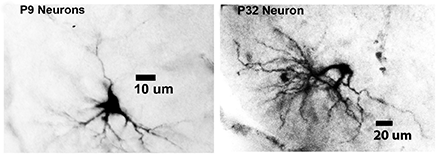Onset of hearing correlated with rapid refinement of neuron inhibition
11-11-2013

Processing complex sounds is crucial for learning language, as any parent of a hearing-impaired child will tell you. Changes in the auditory processing pathway happen very quickly during development, especially at young ages soon after the ability to hear begins. Prof. Edward Bartlett, Ph.D., and Yamini Venkataraman, Ph.D., a recently graduated doctoral student in Biomedical Engineering, investigated one step of this pathway—where sound signals enter the thalamus, a brain structure that provides the majority of sensory information to the cerebral cortex.
While it may seem counter-intuitive, inhibition of neurons is essential as the auditory system learns to process the multitude of complicated signals coming in. The primary inhibitory neurotransmitter, GABA (gamma-Aminobutyric acid), triggers a dampening effect, making the receiving neuron less likely to propagate the signal. The researchers examined GABA inhibition of the auditory region of the thalamus in rat brains of three age groups: right before they are able to hear, immediately after hearing began, and after the auditory system was mostly developed. The study, published this June in the Journal of Neurophysiology, showed that inhibition of neural signals became larger, quicker and more precise as the animals' auditory system changed once they were able to hear.

Faster and more accurate inhibition enables fast and precise fine-tuning of neurons' responses to rapidly changing sounds. For example, this could allow discrimination between two closely related sounds or sounds in quick succession. The auditory thalamus neuron of the pre-hearing rat (image D) shows that the neuron's response decreased rapidly, indicating that it couldn't keep up even with low frequency stimulation. The neuron of the more developed rat (image F), however, responded to each stimulation pulse, indicating much more accurate processing of a changing stimulus. When sound processing in the thalamus doesn't happen properly, the listener is unable to focus on a particular sound, an issue that has been linked to disorders such as schizophrenia, dyslexia, and Alzheimer's disease. Prof. Bartlett's study focused on development in a normal sound environment. Since other studies have shown that auditory development is highly sensitive to the sound environment, future research could involve studying the role of the auditory thalamus during development in abnormal sound conditions (similar to dense urban areas or proximity to a constant noise source like a coast line).
http://www.ncbi.nlm.nih.gov/pubmed/23536710">http://www.ncbi.nlm.nih.gov/pubmed/23536710
Postnatal development of synaptic properties of the GABAergic projection from the inferior colliculus to the auditory thalamus. Venkataraman Y, Bartlett EL. J Neurophysiol. 2013 Jun;109(12):2866-82. doi: 10.1152/jn.00021.2013. Epub 2013 Mar 27.
Writer: Karen Wiggins, 49-44749, wiggins@purdue.edu